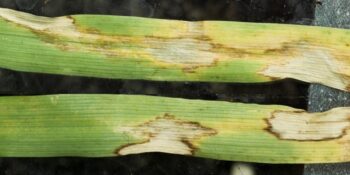Biology and Occurance
Barley leaf blotch is caused by the fungus Rhynchosporium commune (formerly R. secalis). The spores of the pathogen are spread within the crop canopy by rain-splash, this allows the spread of the pathogen into the upper parts of the crop – the severity of epidemics is increased by wet spring weather, while dry weather enables disease escape.
Disease symptoms mainly occur in late summer/autumn (although can occur at other times of the year as well). Note that R. commune can colonise barley crops without causing visual disease symptoms (i.e. transmit from seed to seed without visible infection). R. commune overwinters via infected barley stubble/volunteers and infected seed (also possibly by some infected grass species) – these then infect the developing seedlings. There is no evidence that sexual wind-dispersed ascospores play an important role in initiating disease epidemics.
Symptoms
Visible disease symptoms occur on the ears, leaf sheaths and most noticeably on the leaves but there is also evidence of symptomless infections in some conditions. Young lesions are usually a distinctive water-soaked blue colour, developing later into mature lesions with tan centres with dark margins (see below image). As the disease progresses, foliar lesions can coalesce together and total leaf death can occur.
Management Recommendations
Epidemic severity is mainly influenced by spring rainfall, an increase in rainfall will result in an increase in disease. Leaf scald is favoured by cooler and wetter weather conditions so it is more common in northern and western parts of the UK.
Control of barley leaf blotch is mainly through the use of fungicides with different modes of action. Early application of fungicides is only necessary for Autumn if early disease symptoms are severe. If necessary, disease control in early Spring (GS30) can be helped by the application of an early fungicide. The use of an effective azole with a strobilurin or SDHI fungicide at GS31 is a good foundation for disease management and will be the first treatment for most crops (morpholine can be included for additional control).
Later protection will be needed if cool wet weather favourable to the pathogen occurs between flag leaf emergence (GS39) and ear emergence (GS59), – this can be with an SDHI mixed with a DMI (azole) or strobilurin mixed with an azole.
Recommended Links
Information and images from Rothamsted's Croprotect webpage supported by BBSRC NERC Sustainable Agriculture Research & Innovation Club






